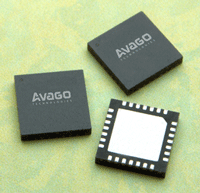- News
20 June 2012
Avago launches wireless products for3G/4G small-cell base stations and portable GPS systems
Avago Technologies (which supplies wireless components for cellular base stations, macrocells, other communications subsystems, and GPS/GLOSNASS positioning systems) has announced the availability of multiple new wireless products targeted at macrocell and small-cell base stations and portable GPS systems.
 “Driven by the unrelenting demand for connectivity everywhere and the huge growth in cellular traffic, picocells and femtocells are helping to offload the macrocells in a heterogeneous network of macrocells and small cells,” says Allen Chien, product manager for Wireless Products. “Avago is delivering new products that deliver high performance and simplify system design by integrating functions previously implemented external to the chips. And that, in turn, saves board space and power,” he adds.
“Driven by the unrelenting demand for connectivity everywhere and the huge growth in cellular traffic, picocells and femtocells are helping to offload the macrocells in a heterogeneous network of macrocells and small cells,” says Allen Chien, product manager for Wireless Products. “Avago is delivering new products that deliver high performance and simplify system design by integrating functions previously implemented external to the chips. And that, in turn, saves board space and power,” he adds.
Power amplifiers in the MGA-43x28 series provide final-stage gain for picocell and enterprise femtocell systems, offering 34–40dB of gain and power-added efficiency ranging from a high of 15–13.8%. The power amplifiers are implemented as a three-stage design and display linearity of 50dBc adjacent-channel leakage ratio (ACLR) at 27.3dBm output power when biased with a 5V supply.
The first three amplifiers in the family (MGA43428, 43528 and 43628) are each targeted at different frequency bands (3GPP bands 5, 2/25 & 1, respectively). All are fabricated using an Avago 0.25µm gallium arsenide (GaAs) enhancement-mode pHEMT process and also include a detector block integrated on the chip. The amplifiers are housed in a 5mm x 5mm package with a footprint 50% that is smaller than comparable devices, it is claimed.
The MGA-16x16 series of balanced ultra-low-noise amplifiers (LNAs) include integrated active biasing and a shutdown functionality. They suit cellular infrastructure applications such as base-station transceiver cards, remote radio heads, tower-mounted amplifiers and base-station combiners. The balanced LNAs deliver what are claimed to be superior return-loss characteristics (S11, 18dB minimum), improving signal quality. Offering a noise figure as low as 0.25dB at 900MHz, the first three members in the family (the MGA-16116, 16216 and 16316) are targeted at the 450–1450MHz, 1440–2350MHz and 1950–2700MHz frequency bands, respectively.
The amplifiers have gain of 18.5dB and deliver twice the linearity of competing devices at 19.1dB at 900MHz, it is claimed. A DC voltage applied to a control pin will shut down the amplifier and bypass it when the system already has sufficient signal strength, preventing over-amplification and signal distortion.
Also new is an integrated filter-LNA module designed to simplify portable navigation systems and embedded GPS/GNSS systems in tablets and cell phones. The AGPS-F001 pairs a patented Avago FBAR (Film Bulk Acoustic Resonator) filter with a low-noise GaAs E-pHEMT amplifier in a single package. The combination gives rejection ranging from 43dBc to 53dBc across the Cell/DCS/PCS/WLAN bands, depending on the frequency band of the signal, and linearity is 10dBm higher in OOB IIP3 versus competing solutions, it is reckoned.
The AGPS-F001 has a typical noise figure of 1.7dB, and the noise-figure distribution is tightly controlled to ensure consistent performance from unit to unit. A CMOS-compatible shutdown pin allows the AGPS-F001 to shut down and reduce its current draw to less than 1µA; during normal operation the filter/amplifier draws 5.5mA from a 2.7V supply and provides a gain of 16.5dB at a frequency of 1.575GHz.
All the amplifiers and filter/amplifier are housed in small leadless packages: the MGA16x16 series in 4mm by 4mm by 0.85mm 16-contact QFN packages, the MGA43x28 series in 5mm by 5mm by 1mm 28-contact QFN packages, and the AGPS-F001 in a 2.3mm by 1.7mm by 0.9mm 6-contact QFN package. Samples are available in June, with production quantities available in fourth-quarter 2012.
Avago LNA GaAs pHEMT Small-cell base stations
